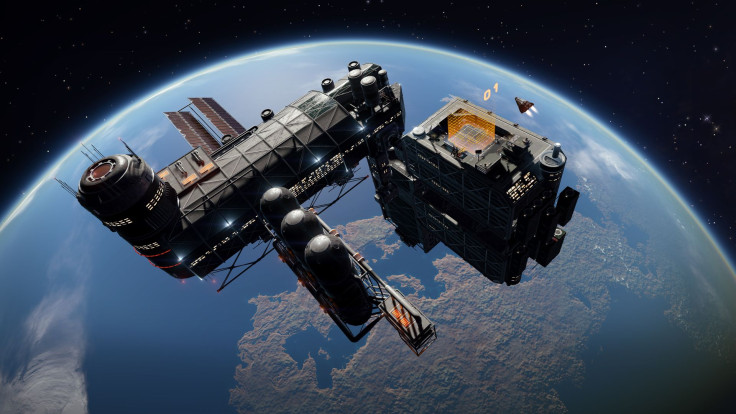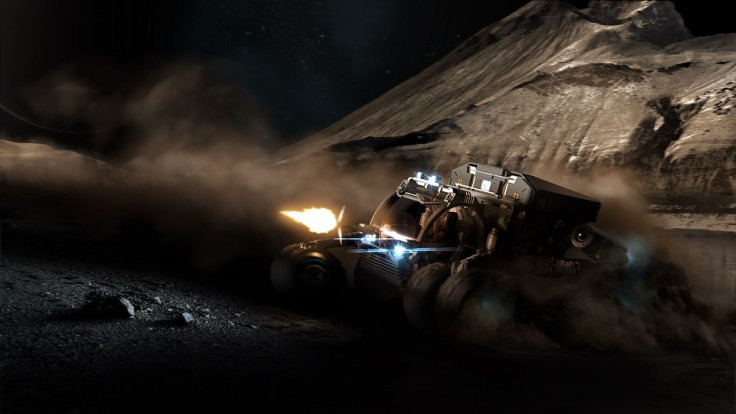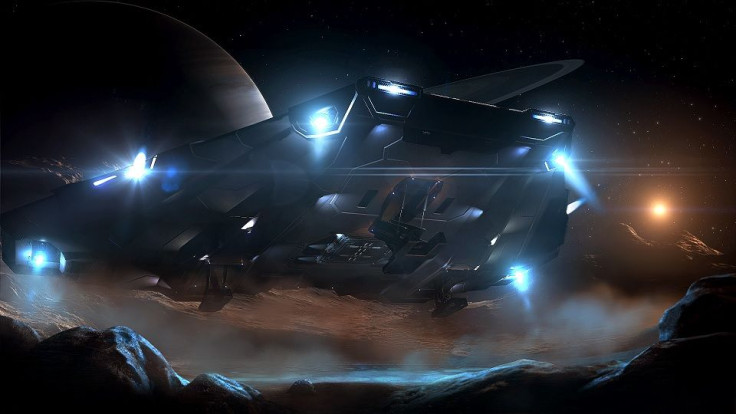It's been a hell of a year for Elite: Dangerous, the space-based, massively-multiplayer title from Frontier Developments, and it doesn't look like things will be slowing down anytime soon. In the months since launch, the studio has published three sizable updates, including the Powerplay Update that went live earlier this summer. A fourth, the upcoming Close Quarters Combat patch, will introduce a new PvP mode that exists entirely separate from the primary Elite: Dangerous experience.
And a chat with Frontier Developments product manager Ben Dowie, recorded in the studio's PAX Prime booth, suggests there's still plenty more for Elite: Dangerous players to look forward to. The cost may not sit well with some segments of the Elite: Dangerous community. But Dowie, along with Frontier PR and Communications manager Michael Gapper, offered a compelling argument for any fans (or outside observers) still on the fence about Elite Dangerous: Horizons.
Without a doubt, the most impressive thing I learned during my conversation with Dowie and Gapper was the sheer scale of the Planetary Landings expansion. It's one thing to know Elite: Dangerous will soon let you visit/explore the various planets included in the game. But it was genuinely difficult for me to maintain composure when Dowie revealed Frontier is creating scale models of each celestial body in ED. That means there are billions, maybe even trillions (or more), of square miles of planetary surfaces opening up to the community when Elite Dangerous: Horizons debuts this holiday season.
The studio takes pride in its realistic approach to science-fiction, right down to its recreation of the Milky Way, which includes all of the stars, planets and other celestial bodies we've already discovered in our home galaxy. Complicated mathematical equations help Frontier fill in the gaps, based on scientific data from around the globe. And the studio is looking to bring that level of detail to every planet in the Milky Way when Planetary Landings debuts. They've even considered the gravitational changes a pilot would encounter, based on the size of the planet, when landing.
"We're going to be taking people down to the planet, in real time," Dowie told iDigi. "Eventually, you'll find yourself close and the gravitational pull of the planet will start to shift the flight model. So the feeling of the craft, and how you have to control it, will suddenly start to change."
The gravitational changes will also be evident when players are driving their recon vehicles, reminiscent of the Mako from Mass Effect. Of course, gravity won't be the only force affecting your driving. Just as you'd expect, Elite Dangerous: Horizons will feature worlds covered in ice, sand and other such terrain that makes for rough driving conditions. Mountains, valleys and other such geographic changes will also impact travel times. And Dowie says all of these factors will impact the way it feels to drive your rover.
"There's a real tangible sense of weight," Dowie said. "You can drive around, get up to about 100 miles per hour, bumping across ravines and feeling the gravity as they float through the air."
The new surface recon vehicles won't be the only potential addition to Elite: Dangerous players' fleets this year. New ships are expected to hit Elite: Dangerous before the end of 2015, bringing the total count to 31. And the upcoming addition of new looting/crafting systems will ensure players have plenty of options for modifying their ship(s) to their liking. But Dowie says players shouldn't expect the vessels in Elite Dangerous: Horizons (and/or future expansions) to get much bigger than they are now.
"I don't think we're going to end up allowing people to fly capital-ship-scale things," Dowie said. "We want to keep it personal. We want to keep people feeling like they're actually a Commander. Once you get to a ship that scale, it starts to get a little bit more implausible. But we are going to be doing some interesting things in Season Two."
Ships may not be getting much bigger but pilots can still expect meaningful changes to be introduced in Elite Dangerous: Horizons. Neither Frontier employee could/would elaborate but the duo did tease the possibility of bringing co-pilots into the equation. When asked whether or not we might finally see extra chairs being filled, either with AI crew members or other Elite: Dangerous players, Gapper smiled and complimented my "astute observation."
"We're going to make people think about ships in a slightly different way." Dowie promised.

Planetary Landings will also incorporate content from Powerplay, including all of the factions introduced in the update, bringing the galactic conflict in Elite: Dangerous down to a global level. Horizons players will be able to take sides in local disputes, between star ports and other such settlements, which may eventually begin to impact surrounding worlds. Over time, these "local" engagements could give one faction a foothold in an area where they'd previously been unrepresented. Or you might see a group forced off of a planet and/or completely out of the system.
Unfortunately, the duo couldn't answer all of my questions. Despite hinting at many of the subjects in our interview, Dowie couldn't offer any sort of information on the specifics of the crafting system coming to Elite: Dangerous or the tougher locales one might discover while exploring. But the studio is confident the four expansions being released as Elite Dangerous: Horizons will justify their $60 price tag.
"Planetary Landings is an enormous undertaking. We've had people working on that since Day One. And those poor guys have been sat away in the office...no one knew what they were doing...and they finally got their day," Dowie said. "We just want to give people as much value as possible. That's why we put out the Loyalty Discount. We don't want people to feel like they've been robbed of anything."
It's the last bit that's proven to be most contentious, following the Elite Dangerous: Horizons reveal at Gamescom, with some fans expressing disappointment over the news. Those new to Elite: Dangerous will have a relatively inexpensive entry-cost, since Horizons includes all of the content from last year's release. But existing Elite: Dangerous players will need to fork over another $50 for a copy of Horizons, despite already owning a substantial portion of the content. And that's not sitting well with some fans.
"Since Day One, when we did the Kickstarter, we always said 'Elite: Dangerous is going to be this' and we're going to commit to paid expansions," Dowie told iDigitalTimes. "What we want to do is give people as much value as possible. So, when we look at sixty dollars, we think the four massive updates we're going to do over the season actually represents enormous value. You just have to look back at this last year, at how much people got, and we're going to be replicating that in this next season."

Before Frontier can turn its full attention to Elite Dangerous: Horizons, the studio must finalize the Xbox One port of Elite: Dangerous that's currently only available to Game Preview participants. Last week, CEO David Braben told fans Frontier is hoping to release the completed Xbox One port on Oct. 6, but the executive's wording has some wondering whether or not that date might slip by a few days/weeks. It also leads to renewed questions about cross-platform play and the effects that PC/console players might have on one another.
Dowie says PC and Xbox players won't ever be flying in the same wing, or even see one another in Elite: Dangerous. But the product manager did confirm every version of Elite: Dangerous and Elite Dangerous: Horizons will share the same universe data. There won't be separate economies for PC and console players, separate servers for those who do/don't own a copy of Horizons, or platform-based forks in the game's narrative. Frontier says events in Elite: Dangerous and Horizons, whether political or economic in nature, will always be reflected on all platforms.
"If the story changes, it changes for everyone," Dowie said. "We can't have the Emperor die on the Xbox and be fine on the PC. It's a real galaxy....when we tick over to next year, it will be 3302. And we want this story to keep going for years to come."
When asked how they see things growing, Dowie and Gapper offered up a variety of scenarios, many of which hinge on groups of players fighting over the various resources/fortifications available on a given planet. Proxy wars seem like an interesting possibility, as the resources or territory needed for certain tasks eventually put PC and console communities in semi-direct competition with one another. Players from different platforms won't ever be able to solve their problems with combat but Frontier wouldn't mind seeing platforms take opposing sides in faction wars.
Elite Dangerous: Horizons will also have plenty of non-PvP content, too. All of the new planets can be scanned, for data that can be sold in other systems, if exploring is more your speed. Planetary Landings will also introduce new resources and other valuable items to give scavengers and miners the incentive needed to step outside their ships from time to time.
"It's like the different parts of a recipe," Dowie said. "We've got all the different ingredients. It's just finding the right mix to have something that's really exciting."
Be sure to check back with iDigitalTimes.com and follow Scott on Twitter for more Elite: Dangerous and Elite Dangerous: Horizons coverage throughout the rest of 2015 and for however long Frontier supports Elite: Dangerous in the years ahead.



















